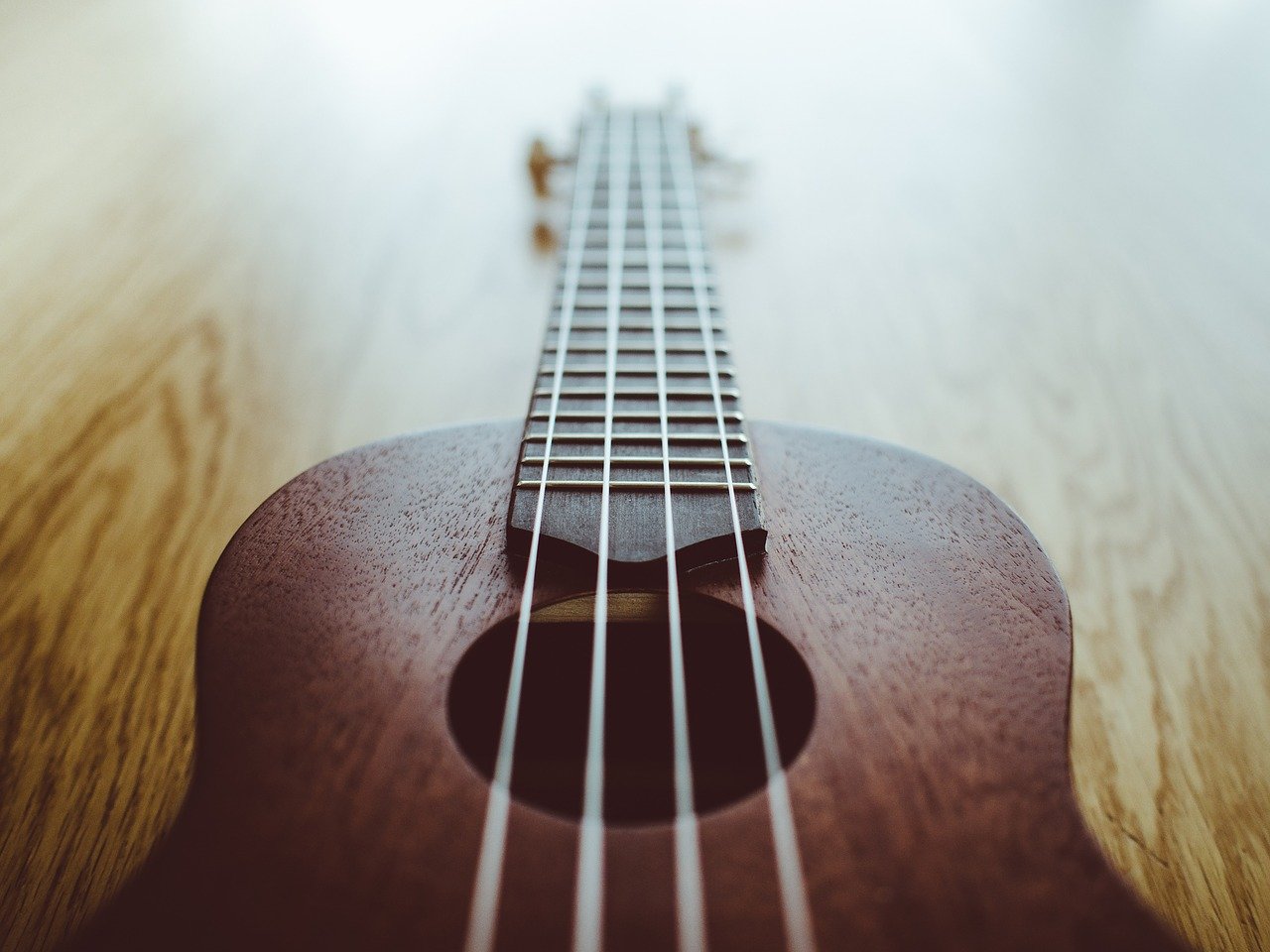Ukulele History Origin to Modern Time
The ukulele, often referred to as a “uke,” is a small, four-stringed instrument belonging to the lute family, with roots tracing back to Portuguese influences and a prominent cultural presence in Hawaii. Pronounced /ˌjuːkəˈleɪli/ (YOO-kə-LAY-lee) in English and [ʔukulele] in Hawaiian, it is known for its bright, cheerful sound. The instrument’s tone and volume vary depending on its size and construction materials. The ukulele comes in four primary sizes: soprano, concert, tenor, and baritone, each with distinct characteristics.
Construction and Materials
Ukuleles are typically crafted from wood, with premium models using solid hardwoods like koa (a Hawaiian acacia), mahogany, or spruce for superior tonal quality. Budget-friendly versions often utilize plywood or laminated woods, sometimes with a spruce soundboard.
Some modern ukuleles are made entirely or partially from plastic or composite materials for affordability and durability. The standard ukulele has a figure-eight body shape, resembling a small acoustic guitar, but unique shapes like the oval “pineapple” ukulele (pioneered by Kamaka Ukulele) or paddle-shaped designs exist.
Strings are typically made of nylon, fluorocarbon, or synthetic gut, though some models use wound strings with a nylon core wrapped in metal (e.g., aluminum or silver-plated copper) for enhanced resonance.Most ukuleles feature four strings, but variants like the taropatch ukulele may have six or eight strings arranged in courses for increased volume. The instrument typically has 16–22 frets, depending on its size, with soprano models having fewer (12–15) and larger models like tenors or baritones having more (up to 21).
History
The ukulele emerged in the 1880s in Hawaii, inspired by Portuguese instruments such as the machete, cavaquinho, and rajão, brought by immigrants from Madeira, the Azores, and Cape Verde. Three Madeiran cabinetmakers—Manuel Nunes, José do Espírito Santo, and Augusto Dias—are credited with creating the earliest ukuleles. After arriving in Hawaii aboard the SS Ravenscrag in August 1879, these immigrants began performing street concerts, as noted in the Hawaiian Gazette.
King David Kalākaua, a passionate supporter of the arts, played a significant role in embedding the ukulele in Hawaiian culture by featuring it in royal performances.The term “ukulele” translates to “jumping flea” in Hawaiian, possibly due to the rapid finger movements of players or linked to the nickname of Edward William Purvis, a small-statured, energetic ukulele player in King Kalākaua’s court. The instrument was documented as a stringed instrument in the 1907 Metropolitan Museum of Art’s Catalogue of the Crosby Brown Collection, describing both soprano and tenor-sized ukuleles from Hawaii.
Global Influence
Canada
In the 1960s, J. Chalmers Doane revolutionized music education in Canada by introducing the ukulele as an accessible, cost-effective tool for teaching musical literacy. His program reached up to 50,000 students and adults at its peak. The modern Ukulele in the Classroom program, developed by Doane and James Hill in 2008, remains a cornerstone of Canadian music education.
Japan
The ukulele arrived in Japan in 1929 when Yukihiko Haida, a Hawaiian-born musician, introduced it after returning to the country. Alongside his brother Katsuhiko, Haida formed the Moana Glee Club, which gained popularity amid a growing interest in Hawaiian and jazz music.
Despite a wartime ban on Western music, the ukulele persisted underground and surged in popularity post-war. In 1959, Haida established the Nihon Ukulele Association, cementing Japan’s role as a hub for ukulele enthusiasts and Hawaiian musicians.
United Kingdom
In the UK, the ukulele gained prominence through performers like George Formby, who played a banjolele (a ukulele-banjo hybrid), and Tessie O’Shea, a Tony Award-winner featured on The Ed Sullivan Show in 1964 alongside The Beatles. The instrument’s simplicity and portability fueled its resurgence in the 21st century.
The Ukulele Orchestra of Great Britain, formed in 1985, continues to tour globally, and the George Formby Society, founded in 1961, hosts regular ukulele conventions. Beatles members George Harrison, Paul McCartney, and John Lennon were avid ukulele players, with Harrison notably teaching the instrument to Tom Petty.
Ukulele History in the United States
The ukulele, a compact four-stringed instrument rooted in Hawaiian culture, has woven itself into the fabric of American music. Its journey from a 19th-century Hawaiian novelty to a modern cultural icon showcases its versatility and enduring appeal. This overview traces the ukulele’s rise in the U.S. mainland, from its Jazz Age prominence to its digital-era resurgence.
Pre–World War II: The Jazz Age Surge
In 1915, the Panama-Pacific International Exposition in San Francisco introduced the ukulele to American audiences through the Hawaiian Pavilion’s performances. George E. K. Awai’s Royal Hawaiian Quartet and ukulele craftsman Jonah Kumalae enchanted visitors, sparking a nationwide fascination with Hawaiian music.
This prompted Tin Pan Alley songwriters to churn out Hawaiian-themed songs, embedding the ukulele in popular culture. Vaudeville stars like Roy Smeck and Cliff “Ukulele Ike” Edwards amplified its appeal, with Smeck featuring in early sound films like Stringed Harmony (1923, DeForest Phonofilm) and His Pastimes (1926, Vitaphone), the latter paired with Don Juan.
The ukulele’s portability and ease of learning made it a Jazz Age staple, with chord tablature appearing in sheet music for popular songs. Manufacturers like Martin, Regal, and Harmony responded to demand by producing ukuleles, banjoleles, and tiples.
The instrument also found a home in early country and old-time music, played by artists like Jimmie Rodgers, Ernest V. Stoneman, and string bands such as Da Costa Woltz’s Southern Broadcasters, The Blankenship Family, and The Hillbillies, often alongside mandolins.
Post–World War II: Sustained Popularity
image credit:
By L. M. Glackens

1916 cartoon by Louis M. Glackens satirizing the contemporary ukulele craze.
From the late 1940s to the 1960s, the ukulele maintained its popularity, driven by Mario Maccaferri’s production of around 9 million affordable plastic ukuleles. Television host Arthur Godfrey boosted the baritone ukulele’s prominence on The Arthur Godfrey Show.
The instrument featured in jazz music through the 1950s to 1970s and gained iconic status in Marilyn Monroe’s performance as Sugar Kane in Some Like It Hot (1959), notably during “Runnin’ Wild.” Singer Tiny Tim’s 1968 hit “Tiptoe Through the Tulips” further highlighted its quirky charm. In the 1920s, Louis Viohl & Sons in Flushing, Queens, added ukuleles to their catalog of guitars and mandolins, reflecting the instrument’s growing market.
Post-1990 Revival
Image credit:Father of JGKlein, used with permission, Public domain, via Wikimedia Commons

Boy in Hawaii wearing lei and holding a Maccaferri “Islander” plastic ukulele
After a decline in the 1970s and 1980s, the ukulele saw a revival in the late 1990s. Jim Beloff fueled this resurgence by publishing over two dozen ukulele music books, blending classic and contemporary songs. Hawaiian artist Israel Kamakawiwoʻole’s 1993 medley of “Over the Rainbow” and “What a Wonderful World” became a global sensation, reaching number 12 on Billboard’s Hot Digital Tracks chart in 2004 and appearing in films, TV, and commercials.
YouTube played a pivotal role, with Jake Shimabukuro’s 2006 cover of George Harrison’s “While My Guitar Gently Weeps” amassing over 17 million views by September 2020. The ukulele’s affordability and simplicity have made it a popular choice in music education, often replacing the recorder, and it is used in solo and ensemble settings, such as Markus Rathey’s arrangements for three ukuleles.
Impact of ukulele in modern Day
Contemporary Impact of the Ukulele
The ukulele’s lively, uplifting sound and user-friendly design have profoundly shaped modern music, culture, and education. Its revival in the late 20th and early 21st centuries has solidified its status as a cherished and adaptable instrument across diverse genres, communities, and platforms. Here’s a look at its influence today.
Education and Accessibility
The ukulele has emerged as a key tool in music education, valued for its low cost, portability, and ease of play. Globally, schools have embraced it as an alternative to the recorder for teaching musical fundamentals. Initiatives like Canada’s Ukulele in the Classroom, created by J. Chalmers Doane and James Hill, engage thousands of students, using the instrument’s simplicity to spark creativity. Its compact size and gentle nylon strings suit young learners, while its affordability makes it accessible across economic backgrounds.
Mainstream Music and Pop Culture
The ukulele’s modern prominence is fueled by its integration into popular music and media. Israel Kamakawiwoʻole’s 1993 rendition of “Over the Rainbow” and “What a Wonderful World” became a global sensation, featured in films, TV, and advertisements, introducing the ukulele to wide audiences. Jake Shimabukuro’s 2006 YouTube performance of “While My Guitar Gently Weeps,” with over 17 million views by 2020, demonstrated its technical depth, inspiring new players. Artists such as Billie Eilish, Twenty One Pilots, and Jason Mraz have woven the ukulele into pop, indie, and folk, expanding its reach beyond Hawaiian traditions.
Digital Platforms and Global Communities
Digital platforms have significantly boosted the ukulele’s popularity. YouTube tutorials, online lessons, and virtual ukulele groups have made learning widely accessible. Platforms like Instagram and TikTok showcase ukulele covers and original works, building global enthusiast networks. Events like the Ukulele Festival of Hawaii and performances by the Ukulele Orchestra of Great Britain, alongside communities like the George Formby Society, sustain the instrument’s legacy through workshops and performances.
Therapeutic and Social Value
With its approachable nature and calming tone, the ukulele is widely used in music therapy, helping reduce stress and enhance emotional health in settings like hospitals and community centers. Its ease of learning encourages beginners, fostering confidence and social bonds through ukulele clubs and group jams. These gatherings, popular in places like the U.S., UK, and Japan, create welcoming environments for players of all ages and abilities.
Design and Innovation

Modern ukulele production has evolved with innovations from brands like Kala and Lanikai, introducing bass and contrabass models to broaden the instrument’s sonic range. Durable materials like carbon fiber and ABS plastic enhance affordability, while unique designs like pineapple or resonator ukuleles cater to varied tastes and tonal needs. These developments keep the ukulele relevant for both hobbyists and professionals.
Cultural Relevance
While rooted in Hawaiian culture, the ukulele has become a global symbol of joy and connection. Its versatility shines in genres like jazz, country, and pop, and its role in education and therapy highlights its unifying power. From viral online moments to classroom melodies, the ukulele’s modern influence lies in its ability to inspire creativity, spread happiness, and unite people across cultures.
Types and Sizes
Ukuleles come in various sizes, each with distinct tonal qualities and tunings:
- Sopranino (Piccolo): ~16 inches, 10–12 frets, often tuned to D5–G4–B4–E5.
- Soprano (Standard): ~21 inches, 12–15 frets, typically tuned G4–C4–E4–A4 (C6 tuning).
- Concert (Alto): ~23 inches, 15–18 frets, tuned G4–C4–E4–A4 or G3–C4–E4–A4.
- Tenor (Taro Patch, Liliu): ~26 inches, 17–19 frets, tuned G4–C4–E4–A4 (high G) or G3–C4–E4–A4 (low G).
- Baritone: ~29 inches, 18–21 frets, tuned D3–G3–B3–E4 (like a guitar’s top four strings).
- Bass: ~30 inches, 16–18 frets, tuned E2–A2–D3–G3.
- Contrabass (U-Bass, Rumbler): ~32 inches, 16 frets, tuned E1–A1–D2–G2.
The soprano, the original size, is the second smallest after the sopranino. The concert and tenor sizes, developed in the 1920s, offer louder and deeper tones, while the baritone, introduced in the 1940s, resembles a small guitar. Bass and contrabass ukuleles, innovations from 2010 and 2014, respectively, provide lower ranges.
Tuning
The most common tuning for soprano, concert, and tenor ukuleles is C6 (G4–C4–E4–A4), known as reentrant tuning due to the high G string being an octave higher than expected. This is often memorized with the “My dog has fleas” jingle. Linear C6 tuning (G3–C4–E4–A4) is common for tenors. The baritone typically uses G6 tuning (D3–G3–B3–E4), matching a guitar’s top four strings. Bass ukuleles are tuned like a bass guitar (E2–A2–D3–G3), while contrabass models use E1–A1–D2–G2.
C6 tuning

Credit:By Hyacinth, CC BY-SA 3.0, Link
D6 tuning (A4–D4–F♯4–B4), once standard in the early 20th century, is now less common but used in Canadian music education (known as “Canadian tuning” when using a low A3). Sopranino ukuleles may use G6 tuning (D5–G4–B4–E5). Alternative tunings, like those for mandolin or slack-key guitar, are sometimes employed by players for specific styles.
Soprano Ukulele Chord Chart (C6 Tuning: GCEA)
This table lists common chords for the soprano ukulele in standard C6 tuning (G4–C4–E4–A4). Numbers indicate the fret to press on each string; “0” means play the string open. The notes column shows the musical notes forming each chord.
| Chord | G String | C String | E String | A String | Notes |
|---|---|---|---|---|---|
| C | 0 | 0 | 0 | 3 | C, E, G |
| G | 0 | 2 | 3 | 2 | G, B, D |
| Am | 2 | 0 | 0 | 0 | A, C, E |
| F | 2 | 0 | 1 | 0 | F, A, C |
| D | 2 | 2 | 2 | 0 | D, F#, A |
| A | 2 | 1 | 0 | 0 | A, C#, E |
| E | 4 | 4 | 4 | 2 | E, G#, B |
| Dm | 2 | 2 | 1 | 0 | D, F, A |
| Em | 0 | 4 | 3 | 2 | E, G, B |
| G7 | 0 | 2 | 1 | 2 | G, B, D, F |
| C7 | 0 | 0 | 0 | 1 | C, E, G, Bb |
| F7 | 2 | 3 | 1 | 0 | F, A, C, Eb |
| D7 | 2 | 2 | 2 | 3 | D, F#, A, C |
| A7 | 0 | 1 | 0 | 0 | A, C#, E, G |

How to Read the Chart
- Strings: Columns represent the ukulele strings from left to right: G (lowest pitch), C, E, A (highest pitch).
- Numbers: Indicate the fret to press on each string. “0” means play the string open (no fretting).
- Notes: Lists the musical notes that form each chord for reference.
- Usage: These chords are versatile for playing many songs in genres like pop, folk, and Hawaiian music. For example, C, G, Am, and F chords can unlock countless beginner-friendly songs.
Notes
- The chart focuses on basic chords for beginners, ideal for the soprano ukulele.
- Finger placements assume standard hand positioning, typically using the index, middle, and ring fingers.
- Ensure proper tuning (GCEA) using a tuner or the “My dog has fleas” mnemonic for best sound.
Related Instruments
The ukulele is related to several instruments, including:
- Portuguese Ancestors: The cavaquinho, machete, and rajão, which influenced its design.
- Hybrids: The guitalele (guitar-ukulele hybrid), banjolele (banjo-ukulele hybrid), harp ukulele, and lap steel ukulele.
- Other Variants: The resonator ukulele (using aluminum cones), Tahitian ukulele (carved from a single piece of wood with an open back), and Motu Nui (a French variant with fishing-line strings and a wah-wah effect hole).
- Global Relatives: The Venezuelan cuatro, Colombian tiple, Canary Islands timple, Mexican requinto jarocho, Andean charango, and Indonesian kroncong.
The Uke Bass is closely related to the leona, a bass instrument in the Mexican son jarocho genre.
Image credit
Koffermejia, CC BY-SA 4.0, via Wikimedia Commons
The ukulele’s journey from a humble Hawaiian creation to a global phenomenon underscores its timeless charm and adaptability. Whether strumming in a classroom, lighting up social media, or soothing souls in therapy sessions, this small instrument continues to make a big impact. As it evolves with new designs and resonates through diverse musical landscapes, the ukulele remains a beacon of joy, uniting players and listeners in a shared celebration of music and community.
Top 10 Best Places to Visit in June in South India | Cool Hill Stations & Scenic Getaways






